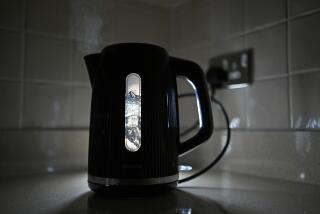DWP recruits JPL to investigate Los Angeles water main breaks
The investigation into what could be causing a sharp rise in “major blowouts” of L.A. water mains has expanded to examine whether tectonic activity might be playing a role.
The Los Angeles Department of Water and Power has asked scientists at the Jet Propulsion Laboratory for help. As it happened, JPL officials were already examining ground movement in the Los Angeles Basin because of several recent minor earthquakes.
Examining the timing and location of the breaks, JPL scientists have noticed “some deviation from the normal range” of ground movement in L.A. in the last 100 days, said Andrea Donnellan, NASA headquarter’s program area co-lead for natural disasters, who works at JPL.
“We’re trying to understand,” she said.
Donnellan said scientists concluded that there has been a change in ground movement by using GPS data from sensors embedded in the earth across the Los Angeles Basin. The sensors, however, have been in place for only a few years, so it’s difficult to say whether the movement in the last 100 days is really an anomaly. The movement detected is fairly subtle and may not be directly related to any increase in the number or intensity of local earthquakes.
As a result, Donnellan said it’s doubtful ground movement is the “primary cause” of the water main breaks.
Los Angeles has seen a surge in recent months in “major blowouts” in the city’s aging water system in which streets have flooded and pavement has buckled -- in some cases damaging homes and businesses. City engineers are trying to determine what’s causing the water main bursts and have been taking soil samples, sending pipe pieces to labs for testing and performing a statistical analysis on each break.
While the DWP said it has not found a cause, experts have offered various theories. Some said a prime suspect could be the city’s recent decision to allow sprinklers to run only on Mondays and Thursdays. They say that if more water flows through the system on those two days, and then pressure suddenly changes on other days, it could put added stress on already aging pipes.
The DWP said it’s too early to determine a cause. But officials confirmed they are seeking assistance from USC, JPL and Cornell University, but declined to comment further.
As part of JPL’s effort, scientists will be analyzing radar data of ground movement taken from a NASA airplane. Donnellan said it could be months before they have any answers.
Engineers also stressed that the city’s 7,200 miles of pipe aren’t actually leaking more than usual -- in fact, the number of leaks, about 1,400 a year, is down from the past and represents a lower rate per mile of pipe than in other cities.
--
More to Read
Sign up for Essential California
The most important California stories and recommendations in your inbox every morning.
You may occasionally receive promotional content from the Los Angeles Times.









